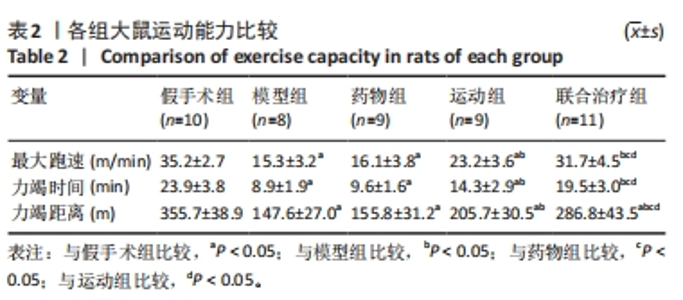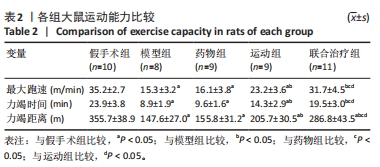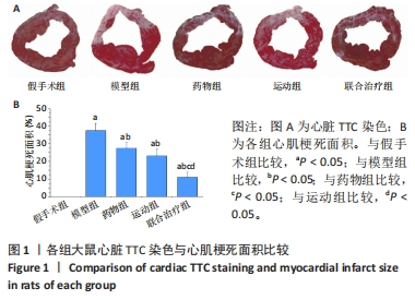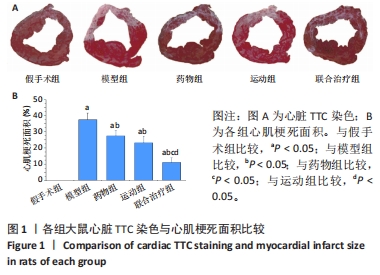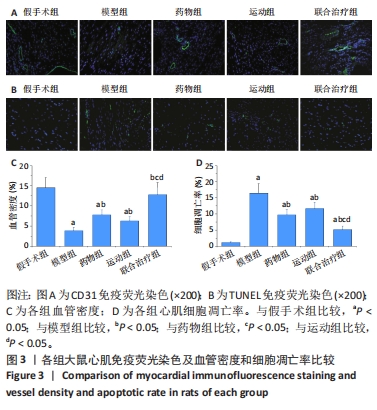Chinese Journal of Tissue Engineering Research ›› 2024, Vol. 28 ›› Issue (31): 4987-4994.doi: 10.12307/2024.703
Previous Articles Next Articles
Granulocyte colony-stimulating factor combined with high-intensity intermittent exercise preconditioning improved cardiac remodeling in rats with acute myocardial infarction
Sun Yuma, Ma Wenchao, Fu Changxi
- Department of Physical Education, Xuzhou University of Technology, Xuzhou 221008, Jiangsu Province, China
-
Received:2023-08-22Accepted:2023-10-12Online:2024-11-08Published:2024-01-22 -
Contact:Fu Changxi, Associate professor, Doctoral candidate, Department of Physical Education, Xuzhou University of Technology, Xuzhou 221008, Jiangsu Province, China -
About author:Sun Yuma, Master, Lecturer, Department of Physical Education, Xuzhou University of Technology, Xuzhou 221008, Jiangsu Province, China -
Supported by:Jiangsu Provincial Social Science Foundation Project, No. 22TYD001 (to FCX)
CLC Number:
Cite this article
Sun Yuma, Ma Wenchao, Fu Changxi. Granulocyte colony-stimulating factor combined with high-intensity intermittent exercise preconditioning improved cardiac remodeling in rats with acute myocardial infarction[J]. Chinese Journal of Tissue Engineering Research, 2024, 28(31): 4987-4994.
share this article
Add to citation manager EndNote|Reference Manager|ProCite|BibTeX|RefWorks
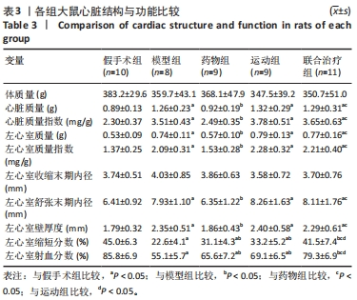
2.3 心脏结构与心功能比较 与假手术组比较,模型组心脏质量、心脏质量指数、左心室质量、左心室质量指数、左心室舒张末期内径和左心室壁厚度增加(P < 0.05),左心室缩短分数和左心室射血分数下降(P < 0.05)。与模型组比较,药物组心脏质量、心脏质量指数、左心室质量、左心室质量指数、左心室舒张末期内径和左心室壁厚度降低(P < 0.05),左心室缩短分数和左心室射血分数升高(P < 0.05);运动组和联合治疗组左心室缩短分数和左心室射血分数升高(P < 0.05)。与药物组比较,联合治疗组心脏质量、心脏质量指数、左心室质量、左心室质量指数、左心室舒张末期内径、左心室壁厚度、左心室缩短分数和左心室射血分数增加(P < 0.05)。与运动组比较,联合治疗组左心室缩短分数和左心室射血分数增加(P < 0.05)。各组体质量和左心室收缩末期内径比较均无统计学意义(P > 0.05)。见表3。"

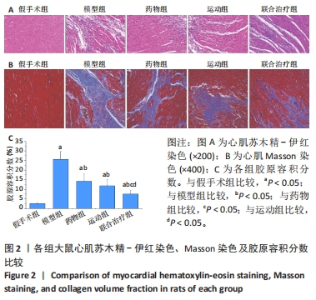
2.5 心肌苏木精-伊红染色、Masson染色及胶原容积分数比较 心肌苏木精-伊红染色显示,细胞质为红色,细胞核为蓝色。假手术组大鼠心肌组织整体结构完整,肌纤维束排列规则、致密,模型组细胞结构受损、肌纤维排列疏松、紊乱,间隔增宽;药物组、运动组和联合治疗组心肌组织排列基本规则、致密、连续,见图2A。心肌Masson染色显示,胶原纤维呈现蓝灰色,肌纤维呈现红色,细胞核呈蓝黑色。假手术组几乎无胶原纤维;模型组可见心肌组织中广泛增生的胶原纤维并将心肌细胞分割,纤维化区域排列紊乱,不规则且致密;药物组、运动组和联合治疗组心肌纤维化程度减轻,见图2B。使用Image J软件对各组大鼠胶原容积分数进行定量评估,结果显示,与假手术组比较,模型组胶原容积分数增加(P < 0.05);与模型组比较,药物组、运动组和联合治疗组胶原容积分数降低(P < 0.05);与药物组和运动组比较,联合治疗组胶原容积分数进一步下降(P < 0.05),见图2C。"
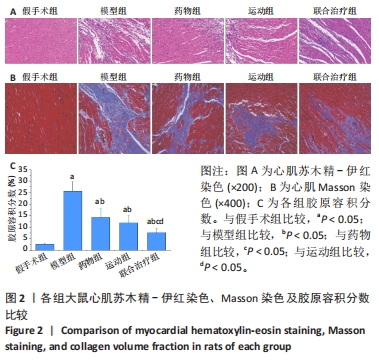

2.7 心肌mRNA表达量比较 与假手术组比较,模型组脑钠肽和β-肌球蛋白重链mRNA表达升高(P < 0.05),α-肌球蛋白重链和肌浆网Ca2+-ATP酶mRNA表达以及α-肌球蛋白重链/β-肌球蛋白重链比值下降(P < 0.05);与模型组比较,药物组、运动组、联合治疗组脑钠肽和β-肌球蛋白重链mRNA表达降低(P < 0.05),α-肌球蛋白重链和肌浆网Ca2+-ATP酶mRNA表达以及α-肌球蛋白重链/β-肌球蛋白重链比值升高(P < 0.05);与药物组和运动组比较,联合治疗组脑钠肽和β-肌球蛋白重链mRNA表达下降(P < 0.05),α-肌球蛋白重链和肌浆网Ca2+-ATP酶mRNA表达以及α-肌球蛋白重链/β-肌球蛋白重链比值升高(P < 0.05),见图4。"
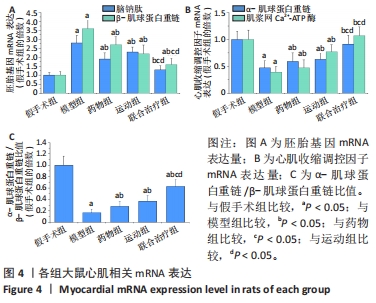

2.8 心肌蛋白表达量比较 干细胞归巢信号通路:与假手术组比较,模型组基质细胞衍生因子1和CXC趋化因子受体蛋白4蛋白表达升高(P < 0.05);与模型组比较,药物组、运动组、联合治疗组基质细胞衍生因子1和CXC趋化因子受体蛋白4蛋白表达增加(P < 0.05);与药物组和运动组比较,联合治疗组基质细胞衍生因子1和CXC趋化因子受体蛋白4蛋白表达进一步升高(P < 0.05),见图5A。 JAK2/STAT3信号通路:与假手术组比较,模型组p-JAK2和p-STAT3蛋白表达下降(P < 0.05);与模型组比较,药物组、运动组、联合治疗组p-JAK2和p-STAT3蛋白表达升高(P < 0.05);与药物组和运动组比较,联合治疗组p-JAK2和p-STAT3蛋白表达进一步升高(P < 0.05),见图5B。 凋亡信号通路:与假手术组比较,模型组Bcl-2蛋白表达下降(P < 0.05),Bax和Cleaved-caspase-3蛋白表达升高(P < 0.05);与模型组比较,药物组、运动组、联合治疗组Bcl-2蛋白表达升高(P < 0.05),Bax和Cleaved-caspase-3蛋白表达下降(P < 0.05);与药物组和运动组比较,联合治疗组Bcl-2蛋白表达进一步升高(P < 0.05),Bax和Cleaved-caspase-3蛋白表达进一步下降(P < 0.05),见图5C,D。"
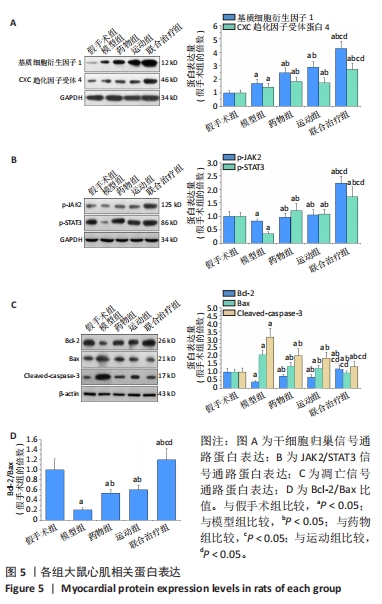
| [1] FRANTZ S, HUNDERTMARK MJ, SCHULZ-MENGER J, et al. Left ventricular remodelling post-myocardial infarction: pathophysiology, imaging, and novel therapies. Eur Heart J. 2022;43(27):2549-2561. [2] PARIZADEH SM, JAFARZADEH-ESFEHANI R, GHANDEHARI M, et al. Stem cell therapy: a novel approach for myocardial infarction. J Cell Physiol. 2019;234(10):16904-16912. [3] KOWALÓWKA AR, WOJAKOWSKI W, BACHOWSKI R, et al. Stem cells mobilization by cardiopulmonary bypass after coronary artery bypass grafting. Postepy Kardiol Interwencyjnej. 2022;18(4):450-458. [4] 殷婷婷,杜大勇,蒋知新,等.粒细胞集落刺激因子改善急性心肌梗死模型大鼠的心肌纤维化[J].中国组织工程研究,2022,26(5): 730-735. [5] WANG W, YE S, ZHANG L, et al. Granulocyte colony-stimulating factor attenuates myocardial remodeling and ventricular arrhythmia susceptibility via the JAK2-STAT3 pathway in a rabbit model of coronary microembolization. BMC Cardiovasc Disord. 2020;20(1):e85. [6] TSIBULNIKOV SY, MASLOV LN, GORBUNOV AS, et al. A review of humoral factors in remote preconditioning of the heart. J Cardiovasc Pharmacol Ther. 2019;24(5):403-421. [7] 李宏玉,张继瑶,张钰,等.运动预处理对心肌缺血再灌注损伤大鼠自噬相关蛋白表达及心肌细胞凋亡的影响[J].中国康复理论与实践,2020,26(8):903-907. [8] DUN Y, SMITH JR, LIU S, et al. High-intensity interval training in cardiac rehabilitation. Clin Geriatr Med. 2019;35(4):469-487. [9] 朱政,付常喜,马文超,等.有氧运动调控自发性高血压模型大鼠心脏重塑的机制[J].中国组织工程研究,2022,26(14):2231-2237. [10] 付常喜,李平,秦永生,等.高强度间歇训练对自发性高血压大鼠肾脏纤维化的影响[J].山东体育学院学报,2020,36(3):75-82. [11] AN J, DU Y, LI X, et al. Myocardial protective effect of sacubitril-valsartan on rats with acute myocardial infarction. Perfusion. 2022; 37(2):208-215. [12] COX EJ, MARSH SA. A systematic review of fetal genes as biomarkers of cardiac hypertrophy in rodent models of diabetes. PLoS One. 2014; 9(3):e92903. [13] REDA SM, GOLLAPUDI SK, CHANDRA M. Developmental increase in β-MHC enhances sarcomere length-dependent activation in the myocardium. J Gen Physiol. 2019;151(5):635-644. [14] SARMA S, MACNAMARA JP, HIEDA M, et al. SERCA2a agonist effects on cardiac performance during exercise in heart failure with preserved ejection fraction. JACC Heart Fail. 2023;11(7):760-771. [15] XU X, XIE X, ZHANG H, et al. Water-soluble alkaloids extracted from aconiti radix lateralis praeparata protect against chronic heart failure in rats via a calcium signaling pathway. Biomed Pharmacother. 2021;135: 111-123. [16] KRISHNAN B, MASSILAMANY C, BASAVALINGAPPA RH, et al. Epitope mapping of SERCA2a identifies an antigenic determinant that induces mainly atrial myocarditis in A/J mice. J Immunol. 2018;200(2):523-537. [17] LIM C, NUNES EA, CURRIER BS, et al. An evidence-based narrative review of mechanisms of resistance exercise-induced human skeletal muscle hypertrophy. Med Sci Sports Exerc. 2022;54(9):1546-1559. [18] WIDMANN M, NIEß AM, MUNZ B. Physical exercise and epigenetic modifications in skeletal muscle. Sports Med. 2019;49(4) 509-523. [19] GIBB AA, HILL BG. Metabolic coordination of physiological and pathological cardiac remodeling. Circ Res. 2018;123(1):107-128. [20] 施曼莉,李晓霞.有氧运动对慢性心力衰竭大鼠病理性心脏肥大的影响[J].体育学刊,2015,22(3):127-134. [21] MARTIN TG, JUARROS MA, LEINWAND LA. Regression of cardiac hypertrophy in health and disease: mechanisms and therapeutic potential. Nat Rev Cardiol. 2023;20(5):347-363. [22] QIU Y, PAN X, CHEN Y, et al. Hallmarks of exercised heart. J Mol Cell Cardiol. 2022;164:126-135. [23] MA M, CHEN W, HUA Y, et al. Aerobic exercise ameliorates cardiac hypertrophy by regulating mitochondrial quality control and endoplasmic reticulum stress through M2 AChR. J Cell Physiol. 2021; 236(9):6581-6596. [24] FISHER S, SMART NA, PEARSON MJ. Resistance training in heart failure patients: a systematic review and meta-analysis. Heart Fail Rev. 2022;27(5):1665-1682. [25] ABDEL-LATIF A, ZUBA-SURMA EK, ZIADA KM, et al. Evidence of mobilization of pluripotent stem cells into peripheral blood of patients with myocardial ischemia. Exp Hematol. 2010;38(12):1131-1142.e1. [26] 梁少兰,杜作义,李自成,等.粒细胞集落刺激因子动员内皮祖细胞对心肌梗死患者心功能的影响[J].实用医学杂志,2014,30(17): 2759-2761. [27] GHANIMATI R, RAJABI H, RAMEZANI F, et al. The effect of preconditioning with high-intensity training on tissue levels of G-CSF, its receptor and C-kit after an acute myocardial infarction in male rats. BMC Cardiovasc Disord. 2020;20(1):e75. [28] JIANG Q, HUANG K, LU F, et al. Modifying strategies for SDF-1/CXCR4 interaction during mesenchymal stem cell transplantation. Gen Thorac Cardiovasc Surg. 2022;70(1):1-10. [29] SHI J, QIN S, WANG R, et al. MicroRNA-362-3p implicated in cardioprotection against hypoxia/reoxygenation-induced cardiomyocyte apoptosis by repressing TP53INP2 and regulating SDF-1/CXCR4 pathway. Altern Ther Health Med. 2023;29(3):254-261. [30] SCHMID M, KRÖPFL JM, SPENGLER CM. Changes in circulating stem and progenitor cell numbers following acute exercise in healthy human subjects: a systematic review and meta-analysis. Stem Cell Rev Rep. 2021;17(4):1091-1120. [31] PUGH JK, FAULKNER SH, TURNER MC, et al. Satellite cell response to concurrent resistance exercise and high-intensity interval training in sedentary, overweight/obese, middle-aged individuals. Eur J Appl Physiol. 2018;118(2):225-238. [32] WANG P, TAO L, YU Y, et al. Oral squamous cell carcinoma cell-derived GM-CSF regulates PD-L1 expression in tumor-associated macrophages through the JAK2/STAT3 signaling pathway. Am J Cancer Res. 2023; 13(2):589-601. [33] NI Y, ZHANG H, ZHANG J, et al. Inhibition of JAK2 by AG490 promotes TNF-α-induced apoptosis by inhibiting autophagy in MC3T3-E1 cells. Pharmazie. 2020;75(6):255-260. [34] 孙晓娟,冯武龙,侯娜.JAK2/STAT3信号通路在运动预适应抗心肌细胞凋亡中的作用[J].中国应用生理学杂志,2017,33(5):393-397. [35] CHEN QM, TU VC. Apoptosis and heart failure: mechanisms and therapeutic implications. Am J Cardiovasc Drugs. 2002;2(1):43-57. [36] ZHANG Y, YANG X, GE X, et al. Puerarin attenuates neurological deficits via Bcl-2/Bax/cleaved caspase-3 and Sirt3/SOD2 apoptotic pathways in subarachnoid hemorrhage mice. Biomed Pharmacother. 2019;109: 726-733. |
| [1] | Lou Guo, Zhang Yan, Fu Changxi. Role of endothelial nitric oxide synthase in exercise preconditioning-induced improvement of myocardial ischemia-reperfusion injury [J]. Chinese Journal of Tissue Engineering Research, 2024, 28(8): 1283-1288. |
| [2] | Xu Wenjie, Xie Xudong, He Ruibo, Ma Gang, Peng peng. Effect and mechanism of angiotensin (1-7) supplementation combined with exercise therapy on cardiac remodeling in rats with renal hypertension [J]. Chinese Journal of Tissue Engineering Research, 2024, 28(26): 4137-4144. |
| [3] | Han Dunzheng, Qin Xiaozhou, Pan Xiudi, Lu Waner, Dai Ying, Chen Yanxun, Cheng Xianfei, Tang Muhan. Effect of apoptosis-inducing factor gene knockdown on bone marrow mesenchymal stem cell transplantation for myocardial infarction [J]. Chinese Journal of Tissue Engineering Research, 2024, 28(25): 3967-3973. |
| [4] | Zhang Min, Lou Guo, Fu Changxi. Aerobic exercise preconditioning improves therapeutic effect of bone marrow mesenchymal stem cells on acute myocardial infarction [J]. Chinese Journal of Tissue Engineering Research, 2024, 28(25): 3988-3993. |
| [5] | Yin Gonghua, Xu Ruoyao, Zhang Lijuan, Zhang Yifan, Qi Jie, Zhang Jun. Regulation of N6-methyladenosine on non-coding RNAs in pathological cardiac remodeling [J]. Chinese Journal of Tissue Engineering Research, 2024, 28(20): 3252-2358. |
| [6] | Sun Yuan, Wang Qingbo, Pi Yihua, Lu Chunmin, Xu Chuanyi, Zhang Yan. Effects of early and late aerobic exercise on right heart failure induced by monocrotaline in rats with pulmonary hypertension [J]. Chinese Journal of Tissue Engineering Research, 2024, 28(2): 177-185. |
| [7] | Tang Liang, Wang Hexia, Wang Qingbo, Pi Yihua, Zhang Yan. Aerobic exercise modulates mitochondrial quality control system to reverse cardiac pathological remodeling in aging rats [J]. Chinese Journal of Tissue Engineering Research, 2024, 28(16): 2534-2541. |
| [8] | Yang Runze, Wang Wei, Chen San, Zhou Xuedong, Wu Jiayuan. Effect of exosomes and the preconditioning method on pulp regeneration [J]. Chinese Journal of Tissue Engineering Research, 2024, 28(13): 2105-2113. |
| [9] | Zhang Liumei, Liu Jingjing, Lin Xiaoye, Liu Lin, Lu Jiao. Mechanism by which high-intensity intermittent exercise improves skeletal muscle injury and enhances exercise capacity in rats [J]. Chinese Journal of Tissue Engineering Research, 2023, 27(35): 5603-5609. |
| [10] | Wang Zhou, Wu Ying. Ischemic preconditioning improves exercise performance: methods, applications and mechanisms [J]. Chinese Journal of Tissue Engineering Research, 2023, 27(30): 4869-4875. |
| [11] | Zhang Yuwei, Liu Chuanchuan, Mao Jiaqi, Zhang Qingqing, Liu Hong, Chen Ying, Ma Lan. Umbilical cord mesenchymal stem cell-derived exosomes treated with hypoxic preconditioning inhibits proliferation of pulmonary artery smooth muscle cells [J]. Chinese Journal of Tissue Engineering Research, 2023, 27(19): 2986-2992. |
| [12] | Kong Dai, Wang Xinkai, Pei Xiaohang, Lian Cheng, Niu Xiaona, Bai Yanliang, Niu Junwei, Zhu Zunmin, Liu Zhongwen. Safety of bendamustine, etoposide, cytarabine, melphalan (BeEAM) as preconditioning in autologous hematopoietic stem cell transplantation for patients with lymphomas [J]. Chinese Journal of Tissue Engineering Research, 2023, 27(19): 2975-2979. |
| [13] | Hou Jingying, Guo Tianzhu, Yu Menglei, Long Huibao, Wu Hao. Hypoxia preconditioning targets and downregulates miR-195 and promotes bone marrow mesenchymal stem cell survival and pro-angiogenic potential by activating MALAT1 [J]. Chinese Journal of Tissue Engineering Research, 2022, 26(7): 1005-1011. |
| [14] | Yin Tingting, Du Dayong, Jiang Zhixin, Liu Yang, Liu Qilin, Li Yuntian. Granulocyte colony-stimulating factors improve myocardial fibrosis in rats with myocardial infarction [J]. Chinese Journal of Tissue Engineering Research, 2022, 26(5): 730-735. |
| [15] | Deng Shuang, Pu Rui, Chen Ziyang, Zhang Jianchao, Yuan Lingyan . Effects of exercise preconditioning on myocardial protection and apoptosis in a mouse model of myocardial remodeling due to early stress overload [J]. Chinese Journal of Tissue Engineering Research, 2022, 26(5): 717-723. |
| Viewed | ||||||
|
Full text |
|
|||||
|
Abstract |
|
|||||
